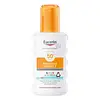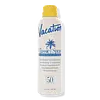What's inside
What's inside
 Key Ingredients
Key Ingredients

 Benefits
Benefits

 Concerns
Concerns

 Ingredients Side-by-side
Ingredients Side-by-side

Water
Skin ConditioningHomosalate
Skin ConditioningGlycerin
HumectantAlcohol Denat.
AntimicrobialButyl Methoxydibenzoylmethane
UV AbsorberEthylhexyl Salicylate
UV AbsorberBis-Ethylhexyloxyphenol Methoxyphenyl Triazine
Skin ConditioningEthylhexyl Triazone
UV AbsorberDibutyl Adipate
EmollientCopernicia Cerifera Cera
EmollientPhenylbenzimidazole Sulfonic Acid
UV AbsorberVp/Hexadecene Copolymer
Glycyrrhetinic Acid
Skin ConditioningGlycyrrhiza Inflata Root Extract
Skin ConditioningSucrose Polystearate
EmollientSodium Stearoyl Glutamate
CleansingHydrogenated Polyisobutene
EmollientMicrocrystalline Cellulose
AbsorbentCellulose Gum
Emulsion StabilisingXanthan Gum
EmulsifyingAcrylates/C10-30 Alkyl Acrylate Crosspolymer
Emulsion StabilisingTetrasodium Iminodisuccinate
Sodium Hydroxide
BufferingSodium Chloride
MaskingTrisodium EDTA
Ethylhexylglycerin
Skin ConditioningPhenoxyethanol
PreservativeWater, Homosalate, Glycerin, Alcohol Denat., Butyl Methoxydibenzoylmethane, Ethylhexyl Salicylate, Bis-Ethylhexyloxyphenol Methoxyphenyl Triazine, Ethylhexyl Triazone, Dibutyl Adipate, Copernicia Cerifera Cera, Phenylbenzimidazole Sulfonic Acid, Vp/Hexadecene Copolymer, Glycyrrhetinic Acid, Glycyrrhiza Inflata Root Extract, Sucrose Polystearate, Sodium Stearoyl Glutamate, Hydrogenated Polyisobutene, Microcrystalline Cellulose, Cellulose Gum, Xanthan Gum, Acrylates/C10-30 Alkyl Acrylate Crosspolymer, Tetrasodium Iminodisuccinate, Sodium Hydroxide, Sodium Chloride, Trisodium EDTA, Ethylhexylglycerin, Phenoxyethanol
Butyl Methoxydibenzoylmethane 2.9%
UV AbsorberHomosalate 8.8%
Skin ConditioningEthylhexyl Salicylate 4.9%
UV AbsorberOctocrylene 8.6%
UV AbsorberAcrylates/Octylacrylamide Copolymer
Alcohol Denat.
AntimicrobialAloe Barbadensis Leaf Extract
EmollientButyloctyl Salicylate
Skin ConditioningButyrospermum Parkii Oil
EmollientCarthamus Tinctorius Seed Oil
MaskingNelumbo Nucifera Extract
Skin ConditioningDiisopropyl Adipate
EmollientEthylhexyl Methoxycrylene
Skin ConditioningParfum
MaskingMusa Sapientum Fruit Extract
Skin ConditioningPolyester-8
Skin ConditioningTocopherol
AntioxidantButyl Methoxydibenzoylmethane 2.9%, Homosalate 8.8%, Ethylhexyl Salicylate 4.9%, Octocrylene 8.6%, Acrylates/Octylacrylamide Copolymer, Alcohol Denat., Aloe Barbadensis Leaf Extract, Butyloctyl Salicylate, Butyrospermum Parkii Oil, Carthamus Tinctorius Seed Oil, Nelumbo Nucifera Extract, Diisopropyl Adipate, Ethylhexyl Methoxycrylene, Parfum, Musa Sapientum Fruit Extract, Polyester-8, Tocopherol
Ingredients Explained
These ingredients are found in both products.
Ingredients higher up in an ingredient list are typically present in a larger amount.
Alcohol Denat. is an alcohol with a denaturant property. It is created by mixing ethanol with other additives.
This ingredient gets a bad rep because it is irritating and drying - mostly due to its astringent property. Astringents draw out natural oils in tissue, constricting pores and leaving your skin dried out.
However, alcohol denat. is not all that bad.
Due to its low molecular weight, alcohol denat. tends to evaporate quickly. One study on pig skin found half of applied alcohol evaporated in 10 seconds and less than 3% stayed on skin.
This also helps other ingredients become better absorbed upon application.
Studies are conflicted about whether this ingredient causes skin dehydration. One study from 2005 found adding emollients to propanol-based sanitizer decreased skin dryness and irritation. Another study found irritation only occurs if your skin is already damaged.
Small amounts of alcohol are generally tolerated by oily skin or people who live in humid environments.
The rule of thumb is if this alcohol is near the end of an ingredients list, it will probably not affect your skin much.
Also...
This ingredient has antimicrobial and solvent properties.
The antimicrobial property helps preserve products and increase their shelf life. As a solvent, it helps dissolve other ingredients.
Other types of astringent alcohols include:
Learn more about Alcohol Denat.Also known as Avobenzone, this ingredient is a chemical sunscreen filter that provides protection in the UV-A range.
Avobenzone is globally approved and is the most commonly used UV-A filter in the world.
Studies have found that avobenzone becomes ineffective when exposed to UV light (it is not photostable; meaning that it breaks down in sunlight). Because of this, formulations that include avobenzone will usually contain stabilizers such as octocrylene.
However, some modern formulations (looking at you, EU!) are able to stabilize avobenzone by coating the molecules.
Avobenzone does not protect against the UV-B range, so it's important to check that the sunscreen you're using contains other UV filters that do!
The highest concentration of avobenzone permitted is 3% in the US, and 5% in the EU.
Learn more about Butyl MethoxydibenzoylmethaneEthylhexyl Salicylate is an organic compound used to block UV rays. It primarily absorbs UVB rays but offers a small amount of UVA protection as well.
Commonly found in sunscreens, Ethylhexyl Salicylate is created from salicylic acid and 2-ethylhexanol. You might know salicylic acid as the effective acne fighter ingredient and BHA.
The ethylhexanol in this ingredient is a fatty alcohol and helps hydrate your skin, similar to oils. It is an emollient, which means it traps moisture into the skin.
According to manufacturers, Ethylhexyl Salicylate absorbs UV wavelength of 295-315 nm, with a peak absorption at 307-310 nm. UVA rays are linked to long term skin damage, such as hyperpigmentation. UVB rays emit more energy and are capable of damaging our DNA. UVB rays cause sunburn.
Learn more about Ethylhexyl SalicylateHomosalate is a chemical sunscreen filter that provides protection in the UV-B range (280nm - 320 nm), with a peak protection at 306 nm. It is internationally approved for use in sunscreens.
Homosalate is not photo-stable, meaning it's strength as a UV filter degrades over time with exposure to the sun. Because of this, it's often used in combination with other chemical sunscreen filters as avobenzone (which protects from the UV-A range). Homosalate also helps act as a solvent for harder-to-dissolve UV filters.
(Part of the reason that sunscreens need to be frequently re-applied is due to the photo instability of many chemical sunscreen filters)
Currently, homosalate is approved in concentrations up to 10% in the EU and 15% in the US. The FDA is currently doing further research on the effects of homosalate, and it is possible that these approved concentrations will change in the future.
Learn more about Homosalate